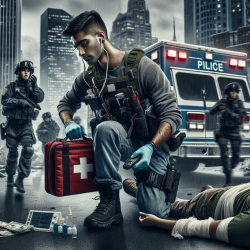Introduction
In the wake of the San Bernardino terrorist incident, first responders faced unprecedented challenges that required swift adaptation and strategic innovation. The comprehensive after-action report by Bobko et al. (2018) offers invaluable insights into the tactical medical responses during such high-stakes situations. This blog aims to explore key lessons from the report and how practitioners can leverage these findings to enhance their skills and improve outcomes in emergency situations.
Understanding the Tactical Medicine Response
The San Bernardino incident underscored the critical role of tactical medicine in modern emergency response. Key differences were highlighted between SWAT paramedics and Rescue Task Force (RTF) paramedics, emphasizing the need for specialized training and equipment. Practitioners can benefit from understanding these distinctions and advocating for comprehensive training programs that address both tactical and medical priorities.
Key Lessons and Implementation Strategies
- Lesson 1: Specialized Training for SWAT and RTF Paramedics
SWAT paramedics are trained to operate within the hot zone, providing medical support under direct threat. In contrast, RTF paramedics focus on rescue operations in the warm zone. Practitioners should advocate for training that bridges these roles, ensuring interoperability and effective communication during joint operations.
- Lesson 2: Establishing a Law Enforcement Medical Coordinator (LEMC)
Introducing a LEMC within the command structure can enhance coordination between tactical and medical teams. This role is crucial for managing resources, conducting threat assessments, and ensuring seamless integration of medical and tactical priorities. Practitioners should consider this role's potential impact on improving response efficiency and advocate for its implementation in their agencies.
- Lesson 3: Adapting to Modern Threats
Modern terrorist events often involve multiple attackers and improvised explosive devices (IEDs). Practitioners should update their training to address these evolving threats, focusing on both ballistic and blast injuries. This includes equipping responders with adequate personal protective equipment (PPE) and medical supplies tailored to these scenarios.
- Lesson 4: Addressing Post-Traumatic Stress (PTS)
First responders are at risk of developing PTS due to the traumatic nature of these incidents. Practitioners should implement mechanisms for early recognition and intervention, promoting adaptive responses and peer support. Creating a supportive environment for open discussions can mitigate long-term psychological impacts.
Encouraging Further Research
The San Bernardino report serves as a foundation for ongoing research and development in tactical medicine. Practitioners are encouraged to delve deeper into the findings and explore innovative solutions to enhance emergency response capabilities. By staying informed and engaged with the latest research, practitioners can drive meaningful change in their communities.
Conclusion
The San Bernardino incident has reshaped the landscape of tactical medicine, highlighting the need for continuous learning and adaptation. By implementing the lessons learned and advocating for further research, practitioners can play a pivotal role in enhancing emergency response and safeguarding communities.
To read the original research paper, please follow this link: A Tactical Medicine After-action Report of the San Bernardino Terrorist Incident.










